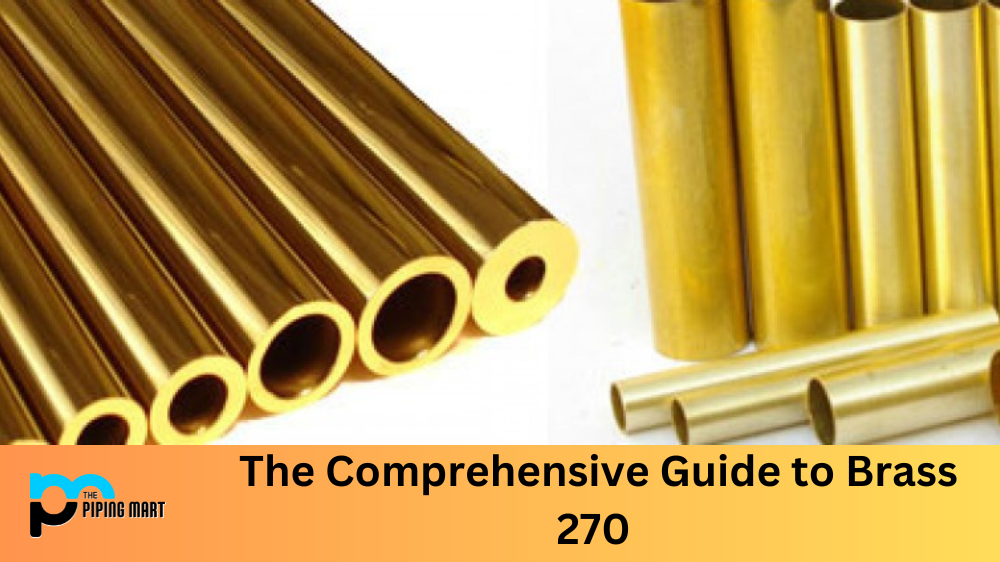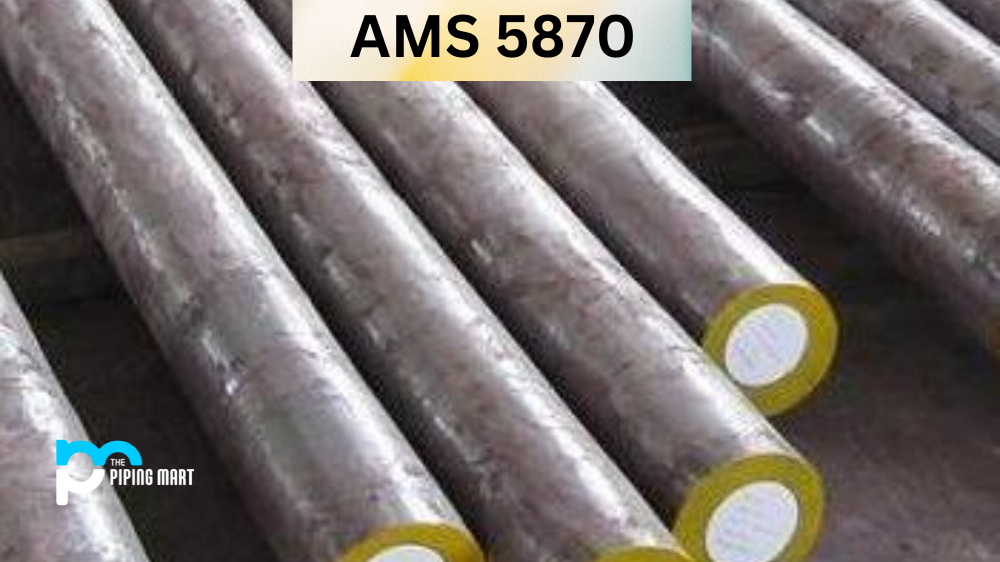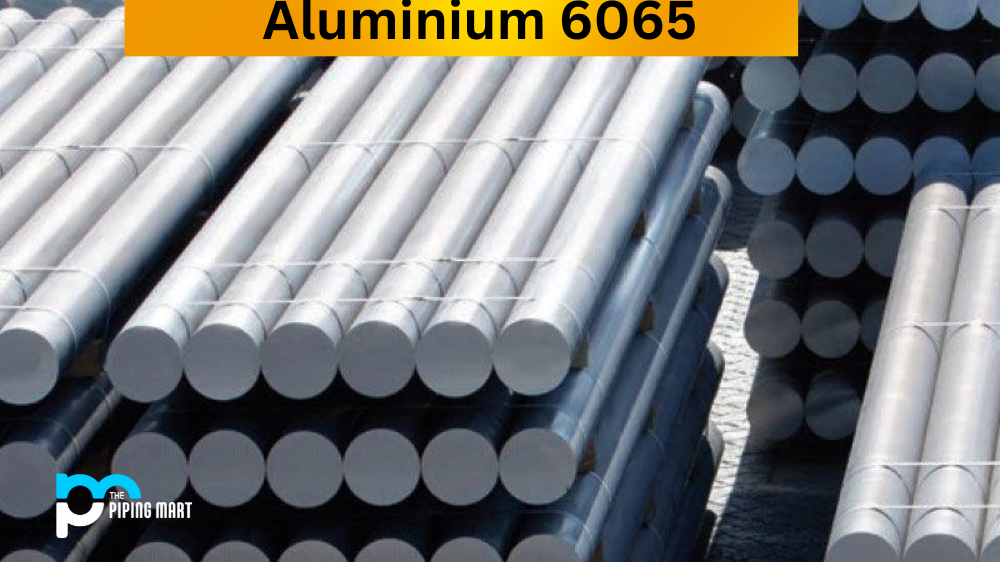If you’re looking for a strong, corrosion-resistant material with many applications and uses, then brass 270 is an excellent choice. Brass 270 is a copper-zinc alloy used in industrial settings due to its impressive strength and resistance to wear. Whether you’re looking for a material for welding or machining or for use in heat treatment processes, brass 270 can provide you with the reliable performance and durability you need. Let’s dive into this comprehensive guide to Brass 270 and all its properties, uses, and more.
What is 270 Brass?
270 Brass is an alloy primarily made up of copper and zinc. This versatile metal is popularly used in various industrial contexts, such as in ammunition casings, musical instruments, marine hardware and other casting techniques. It is suited for cold forming thanks to its structural integrity, making it less prone to cracking or breaking under pressure. It also has a low melting point, making forming into different shapes and sizes easier. Its high corrosion resistance means it can be used without worry in many applications, even in areas with high humidity and salinity levels. All these factors make 270 Brass one of the most sought-after alloys among engineers due to its convenience and strength.
What Forms is 270 Brass Available at Piping Mart?
- Brass 270 Tubing
- Brass 270 Bolts
- Brass 270 Nuts
- Brass 270 Fasteners
- Brass 270 Screw
- Brass 270 Stud Bolts
270 Brass Composition
UNS C28000 brass is an alloy of 67% copper and 33% zinc by weight. It has a melting point of 883°F (475°C) and a tensile strength of 83 ksi (572 MPa). It also boasts excellent machinability, making it ideal for industrial settings requiring precision workmanship. Furthermore, brass 270 C27000 has good ductility, making it well-suited for cold working processes such as deep drawing or bending.
| Element | Content (%) |
|---|---|
| Cu | 59-63 |
| Fe | 0.070 |
| Pb | 0.30 |
| Zn | 40 |
270 Brass Chemical Properties
Brass 270 contains trace amounts of other elements such as lead, iron, arsenic, tin, phosphorus, sulphur, manganese, nickel and aluminium. These trace elements improve corrosion resistance compared to other pure copper-zinc alloys. This corrosion resistance makes brass 270 ideal for applications where regular exposure to moisture or saltwater may occur. Additionally, these trace elements increase the alloy’s wear resistance over time, making it perfect for high-wear environments such as machine parts or tools subjected to regular use or friction.
UNS C28000 Brass Mechanical Properties
Brass 270 is yellow brass that offers a broad range of mechanical properties. This alloy has excellent formability, tensile strength, and corrosion resistance in saltwater atmospheres. Furthermore, its good thermal conductivity and cold working properties are ideal for shipbuilding and marine engineering applications. Its machinability is also excellent–many manufacturers can take advantage of its fast-cutting capabilities compared to other materials. However, C27000 Yellow Brass should be used cautiously when exposed to sulphide environments as it tends to corrode rapidly under its influence.
| Properties | Metric | Imperial |
|---|---|---|
| Hardness, Rockwell F | 78 | 78 |
| Tensile strength | 360 MPa | 52200 psi |
| Yield strength | 140 MPa | 20300 psi |
| Elongation at break (In 50 mm) | 52% | 52% |
| Machinability (UNS C36000 (free-cutting brass) = 100) | 40 | 40 |
| Shear modulus | 39 GPa | 5660 ksi |
| Shear strength | 270 MPa | 39200 psi |
| Poisson’s ratio | 0.34 | 0.34 |
| Elastic modulus | 117 GPa | 16969 ksi |
270 Brass Physical Properties
Brass 270 is a type of red brass that has been found to have excellent physical properties. It has an exceptionally high strength-to-weight ratio and is also shown to be highly resistant to corrosion and has superior wear resistance – making it ideal for use in various applications. UNS C28000 is austenitic and nonmagnetic and maintains its strength in higher temperatures than other materials, making it an ideal choice for demanding environments where temperature issues may be present.
| Properties | Metric | Imperial |
|---|---|---|
| Melting point-liquidus | 904°C | 1660°F |
| Melting point-solidus | 899°C | 1650°F |
| Density | 8.39 gm/cm3 @ 20°C | 0.303 lb/in3 @ 68°F |
Brass 270 Uses
Brass C27000 is one of the most versatile metals in the world and has been used by civilizations for centuries. It has a wide range of applications, and Brass 270 is highly valued due to its good corrosion resistance, low magnetism, good electrical conductivity, and machinability. It is often used to make gears, nuts, valves, electrical components, frameworks and pumps in water-based systems. Brass 270 also provides cost-effectiveness compared to stainless steel or other materials so that even small businesses can afford it. Its reworking and reusing ability makes it popular across many industries, including automotive manufacturing and piping systems. With so many properties ideal for modern engineering requirements, it’s no surprise that Brass 270 is such a respected metal.
- Jewellery
One of the most popular uses for brass is in jewellery making. Brass has a beautiful golden colour that can add a touch of elegance to any piece of jewellery. Brass is also a very strong metal, so it can be used to create beautiful and durable pieces.
- Musical Instruments
Brass is also famous for musical instruments, particularly horns and trumpets. The metal can produce a bright, loud sound perfect for playing in an orchestra or band. Also, brass instruments are durable and can last for many years with proper care.
- Home Decor
Brass is often used in home decor, as it can add a touch of luxury to any room. Brass items such as candlesticks, vases, and picture frames can be found in many homes. Additionally, brass hardware can add a touch of elegance to furniture.
- Lighting
Brass 270 is also popular for lighting fixtures, as it can create a warm, inviting ambience in any room. Chandeliers, lamps, and sconces made from brass are commonly found in homes and businesses.
- Door Hardware
Another everyday use for brass is in-door hardware. Brass doorknobs and knockers can add a touch of class to any entryway. Also, brass hinges are strong and can provide years of trouble-free use.
- Plumbing Fixtures
Brass is also often used in plumbing fixtures such as faucets and valves. The metal is corrosion-resistant and can withstand high temperatures, making it ideal for plumbing applications. Additionally, brass fixtures often have a very attractive finish that can enhance the look of any bathroom or kitchen.
Brass 270 Specifications
| Form | Specific Sub-Form | Application | System | Standard |
| Brass 270 Bolts | ASTM | F468 | ||
| Brass 270 Nuts | ASTM | F467 | ||
| Brass 270 Rod | SAE | J461 | ||
| SAE | J463 | |||
| Brass 270 Rod, Brass 270 Bar & Shapes | ASTM | B927/B927M | ||
| Brass 270 Screws | ASTM | F468 | ||
| Brass 270 Studs | ASTM | F468 | ||
| Brass 270 Tube | ASTM | B135 | ||
| Seamless (Metric) | ASTM | B135/B135M | ||
| Seamless | ASME | SB135 | ||
| ASTM | B587 | |||
| Brass 270 Wire | AMS | 4712 | ||
| SAE | J463 |
270 Brass Corrosion Resistance
If you are looking for a corrosion-resistant material for industrial applications, C270 Brass offers unparalleled protection. While it is known for its malleability and ductility, it is equally famed for its extraordinary ability to resist corrosion in acidic environments. It contains small amounts of zinc, manganese and other materials, which all combine to give the alloy an enhanced level of protection from premature oxidation and other forms of chemical damage. This makes it the ideal choice for many industries where long-term use with maximum safety is a priority.
270 Brass Heat Resistance.
When looking for a material that can withstand intense heat levels without sacrificing structural integrity, brass 270 should be considered carefully. Heat resistance is an important factor in various industrial processes, and brass 270 is designed to keep its strength and integrity at temperatures up to 1000°F. This makes it an excellent choice for applications where heat exposure, such as chemical processing or an automobile engine, is a serious concern. Because of its flexibility and durability, brass 270 is often used in construction projects, including electrical components and piping. It has also remained stable in acidic environments, making it even better suited for chemical engineering.
270 Brass Heat Treatment
Heat-treating brass can create various structures that behave differently under stress and strain. One of the most desirable effects of heat-treating brass is created through 270 wsm Brass heat treatment, which is the process of heating and cooling to maintain equilibrium between two phases present in crystalline bodies, known as alpha and beta phases. This produces high hardness, increased strength, and reduced plasticity. In addition to these properties, 270 Brass heat treatment provides superior wear resistance against abrasion and corrosion. With its wide range of benefits, this heat treatment is often used for making precision parts in motorsports, marine, aerospace and agricultural industries.
270 Brass Machining
Brass 270 machining is a complex crafting process used to produce components with precise measurements and high quality. It requires highly specialized machinery and experienced operators with expertise in this area to achieve the desired outcome. The parts produced using brass 270 machining are often necessary for safety-critical applications due to their reliability, making it an invaluable process. It is efficient and environmentally friendly as the energy required to turn is significantly lower than traditional milling and grinding processes. This type of precision engineering allows manufacturers to create intricate parts for various applications quickly and effectively, allowing them to meet the demand for top-of-the-line products.
270 Brass Welding
Welders have long praised brass 270 welding for its high strength and longevity. It is an excellent choice for welding copper alloys, mainly when precision and reliability are essential. This welding process provides a strong, lasting bond with low contamination levels, ensuring the product maintains its integrity. Brass 270 offers superior arc management and less risk of porosity or cracking than other brass welding forms. While it may take some extra practice to perfect Brass 270 welds, the result can be superior even when faced with challenging environments based on temperature or exposure levels. Many welders swear by this versatile and reliable form of welding.
Conclusion
From welding rods and wire mesh construction projects to electrical connectors and metal forming processes—brass 270 is an incredibly versatile material that provides superior performance when exposed to moisture or extreme temperatures. With its impressive strength properties, superior corrosion resistance, and good ductility factors, this alloy has become one of the most popular choices among industrial manufacturers worldwide today! So, if you’re looking for a reliable material that offers superior performance while being cost-effective, look no further than brass270.

Pipingmart is B2B portal specializes in industrial, metal and piping products. Also, share latest information and news related to products, materials and different types grades to help business dealing in this industry.




